Yesterday, Marlene Pilaete infomed us that exotic dancer and film actress Laya Raki has passed away on 21 December 2018. During the 1950s, she was a popular sex symbol in Germany. Raki appeared in revealing outfits in films and on photos, and captured men's attention like no other German showgirl. Later, 'the black-haired volcano' also became an international star with her roles in British films and TV productions. Laya Raki was 91.
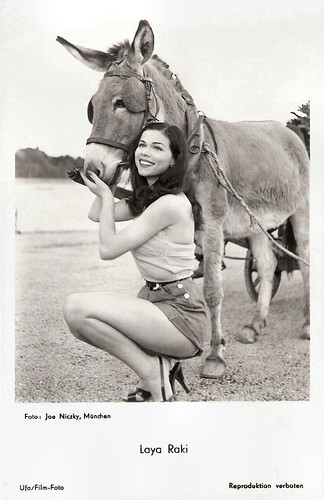
Austrian postcard by HDH-Verlag (Verlag Hubmann), Wien (Vienna). Photo: Joe Niczky, München (Munich) / Ufa.
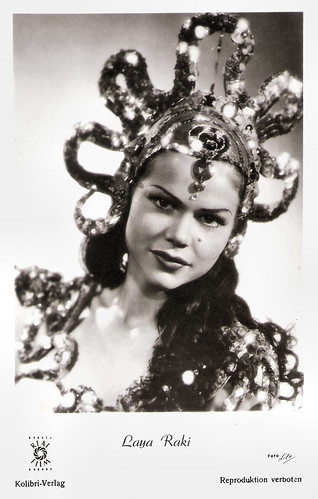
German postcard by Kolibri-Verlag. Photo: Real Film / Lilo. Publicity still for Die Dritte von rechts/Third from the Right (Géza von Cziffra, 1950).
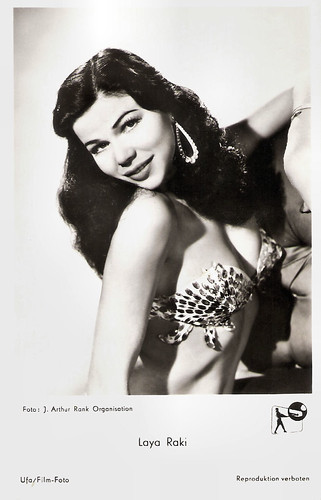
German postcard by Ufa, Berlin-Tempelhof, no. FH 1160. Photo: J. Arthur Rank Organisation. Publicity still for The Seekers (Ken Annakin, 1954).
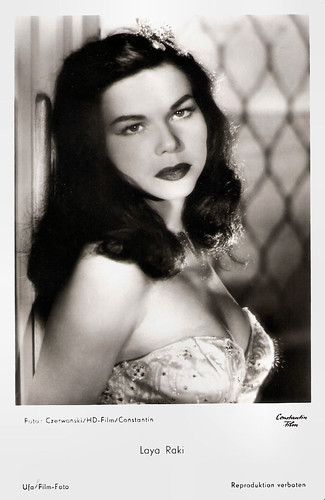
German postcard by UFA, Berlin-Tempelhof, no. FK 1697. Photo: Czerwonski / HD-Film / Constantin. Publicity still for Die Frau des Botschafters/The Ambassador's Wife (Hans Deppe, 1955).
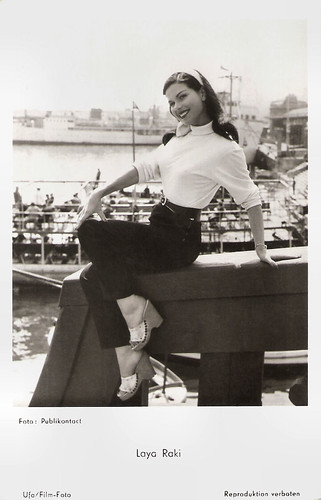
German postcard by UFA, Berlin-Tempelhof, no. FK 1905. Photo: Publikcontact.
Laya Raki was born Brunhilde Marie Alma Herta Jörns in Calvörde near Brunswick, Germany, in 1927. Her parents were acrobat Maria Althoff, and her partner, acrobat and clown Wilhelm Jörns. Her mother left when Brunhilde was five and life was tough in the immediate aftermath of the war in occupied Germany.
As Brunhilde was an admirer of the legendary dancer La Jana and liked to drink raki, she assumed her stage name Laya Raki. The seventeen-year old Laya made ends meet by cashing in on the fad for erotic cabaret by performing striptease, initially at the Monte Carlo club in Berlin. With a solid background in ballet and having followed in her father's footsteps as an acrobat, she found herself perfectly suited to performing all manner of exotic and alluring dances.
She attracted attention for the first time in 1947-1950 as a glamour dancer (in German: Schönheitstänzerin) in Frankfurt and other German cities. When she performed again in Berlin, her star began to rise: her 38-23-36 figure and erotic radiance became the talk of the town. With her new-found fame as Germany's most popular night club performer came engagements in Scandinavia, Switzerland and Italy.
Film company DEFA engaged her for a small role as a rumba dancer in Der Rat der Götter/The Council of the Gods (Kurt Maetzig, 1950), which won two awards. The Berliner Morgenpost reported that she was a great dancer with an expressive face, rich in nuances.
That same year the press department of Realfilm presented her as their new discovery in Die Dritte von rechts/The Third from the Right (Géza von Cziffra, 1950), starring Vera Molnar. It was a rather boring revue film, but the highlight was the scene in which the scantily clad Raki (with only two white stars on her nipples) exposed herself to the lustful gazes of the cinema audiences.
In 1953, she danced in Ehe für eine Nacht/Marriage for One Night (Viktor Tourjansky, 1953), starring Gustav Fröhlich, Hannelore Bollmann and Adrian Hoven, and in Die Rose von Stambul/The Rose of Stamboul (Karl Anton, 1953), Austrian actor Paul Hörbiger wanted to marry her upon seeing her dancing.
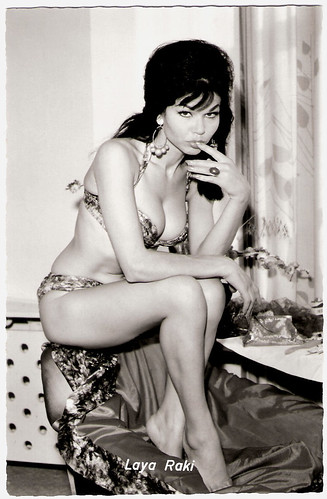
German postcard by Kolibri-Verlag G.m.b.H., Minden/Westf., no 1637.
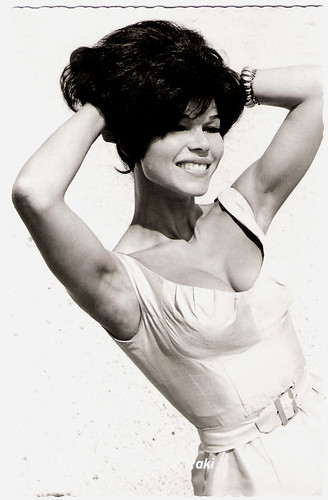
German postcard by Kolibri-Verlag G.m.b.H., Minden/Westf., no 1775.
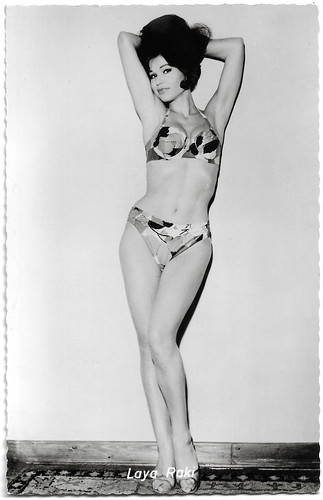
German postcard by Kolibri-Verlag, Minden, no. 1941.
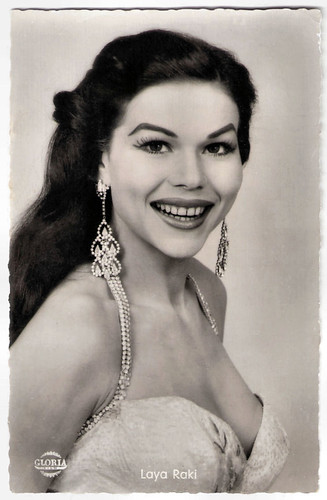
German postcard by Kolibri-Verlag, Minden/Westf., no. 2366. Photo: Sascha / Lux / Gloria Film / Miczky. Publicity still for Roter Mohn/Red Poppy (Franz Antel, 1956).
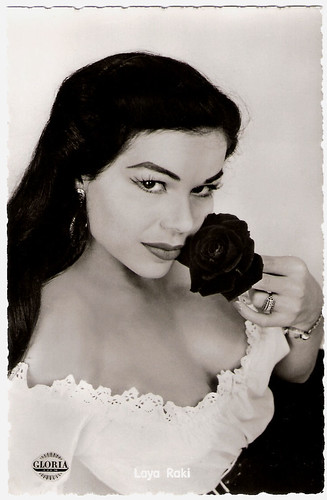
German postcard by Kolibri-Verlag G.m.b.H., Minden/Westf., no 2556. Photo: Sascha-Lux-Gloria-Film / Niczky. Publicity still for Roter Mohn/Red Poppy (Franz Antel, 1956).
In 1954, Laya Raki was lured to London by a swindler with empty promises of film roles in the United Kingdom and Hollywood. This was bigamist and serial fraudster Arthur Howard Rowson, posing as big-time producer and director 'Major Michael Howard'. Her unemployed situation made headlines in the British newspapers which in turn opened opportunities quickly. Howard is sentenced at London’s Old Bailey to seven years preventive detention
The J. Arthur Rank Film Company, which needed a slightly exotic type for a film in New Zealand, received her with open arms. They gave Raki the role of the seductive wife of a Maori chieftain's in The Seekers (Ken Annakin, 1954) opposite Jack Hawkins and Glynis Johns. She created a worldwide stir by baring her breasts.
Next she played in the comedy Up to His Neck (John Paddy Carstairs, 1954) and in the adventure film Quentin Durward (Richard Thorpe, 1955) starring Robert Taylor. She also appeared in the revue 'Cockles and Champagne', presented and produced by Cecil Landau. In Germany, she acted in film productions like Am Anfang war es Sünde/The Beginning Was Sin (Frantisek Cáp, 1954) with Viktor Staal, and Die Frau des Botschafters/The Ambassador's Wife (Hans Deppe, 1955) with Ingrid Andree.
In the Heimatfilm Roter Mohn/Red Poppy (Franz Antel, 1956) she played the gypsy girl Ilonka and conducted refreshing dialogues with famous Viennese comic Hans Moser. After some acting lessons in Hollywood, she appeared in several British TV productions, including 39 episodes of the series Crane (1962-1965). She played Moroccan dancer and bartender Halima, the partner of smuggler Richard Crane (Patrick Allen).
In the meantime she modeled for postcards, pin-up photos and magazines all over the world. In 1962, she recorded the songs 'Faire l'amour' and the twist song 'Oh Johnny hier nicht parken' (Oh, Johnny don´t park here). The latter was banned by a Nuremberg court who thought her ecstatic moaning was imitating coitus.
She continued to play in German films, including the Krimis Die Nylonschlinge/Nylon Noose (Rudolf Zehetgruber, 1963) with Dietmar Schönherr, and Das Haus auf dem Hügel/The House on the Hill (Werner Klingler, 1964) starring Australian-born actor Ron Randell. She also appeared with him in her last film, Savage Pampas (Hugo Fregonese, 1966) starring Robert Taylor.
In 1957, Laya Raki had married Ron Randell in London. They appeared together on the Sydney stage in 'Come Live with Me'. “He is the best and most beautiful man of the world”, she told the press, and she remained at his side until his death in 2005. Her second husband was Duane O. Wood, a former vice president of Lockheed International. They married in 2009 and lived in Los Angeles. There her busband died earlier in 2018, and Laya passed away on 21 December 2018.

German postcard by ISV, no. C 10. Photo: Sascha-Lux / Gloria / Grein. Publicity still for Roter Mohn/Red Poppy (Franz Antel, 1956).
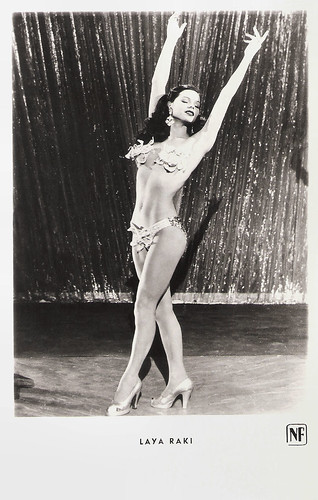
German postcard by Netter's Star Verlag, Berlin, no. A 741. Photo: NF. Publicity still for Ehe für eine Nacht/Marriage for One Night (Viktor Tourjansky, 1953).
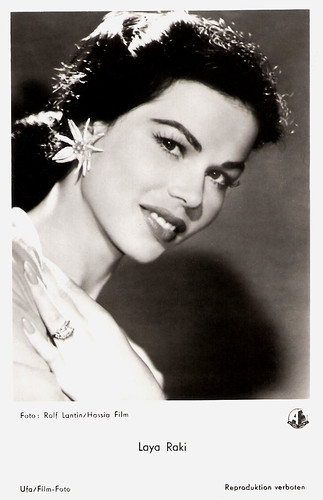
German postcard by Ufa/Film-Foto, Berlin-Tempelhof, no. A FK 3120. Photo: Rolf Lantin / Hassia Film / Allianz Film. Publicity still for Kuss mich noch einmal/Kiss me one more time (Helmut Weiss, 1956).
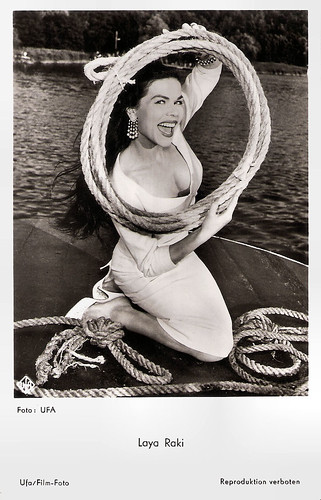
German postcard by Ufa, Berlin-Tempelhof, no. FK 3695.
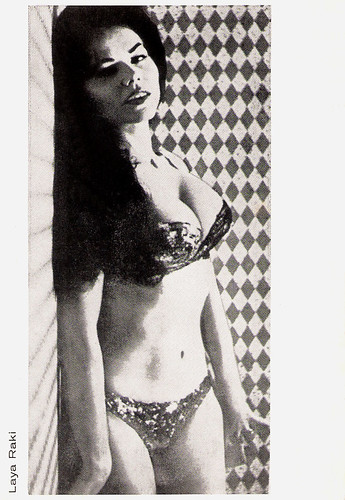
Vintage postcard.

German postcard by WS-Druck, Wanne-Eickel, no. 142. Photo: Sascha-Lux-Gloria-Film / Niczky.
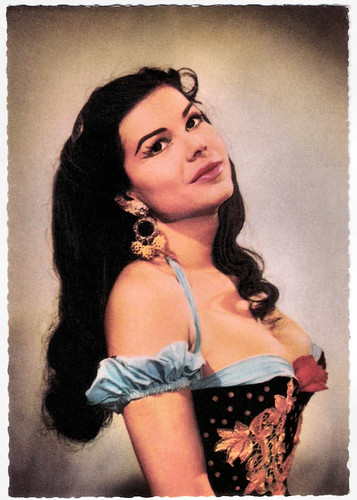
German postcard by ISC, no. C 7. Photo: Sascha / Lux / Gloria / Grein. Publicity still for Roter Mohn/Red Poppy (Franz Antel, 1956).
Sources: I.S. Mowis (IMDb), Glamour Girls of the Silver Screen, Wikipedia, and IMDb.

Austrian postcard by HDH-Verlag (Verlag Hubmann), Wien (Vienna). Photo: Joe Niczky, München (Munich) / Ufa.

German postcard by Kolibri-Verlag. Photo: Real Film / Lilo. Publicity still for Die Dritte von rechts/Third from the Right (Géza von Cziffra, 1950).

German postcard by Ufa, Berlin-Tempelhof, no. FH 1160. Photo: J. Arthur Rank Organisation. Publicity still for The Seekers (Ken Annakin, 1954).

German postcard by UFA, Berlin-Tempelhof, no. FK 1697. Photo: Czerwonski / HD-Film / Constantin. Publicity still for Die Frau des Botschafters/The Ambassador's Wife (Hans Deppe, 1955).

German postcard by UFA, Berlin-Tempelhof, no. FK 1905. Photo: Publikcontact.
Erotic Radiance
Laya Raki was born Brunhilde Marie Alma Herta Jörns in Calvörde near Brunswick, Germany, in 1927. Her parents were acrobat Maria Althoff, and her partner, acrobat and clown Wilhelm Jörns. Her mother left when Brunhilde was five and life was tough in the immediate aftermath of the war in occupied Germany.
As Brunhilde was an admirer of the legendary dancer La Jana and liked to drink raki, she assumed her stage name Laya Raki. The seventeen-year old Laya made ends meet by cashing in on the fad for erotic cabaret by performing striptease, initially at the Monte Carlo club in Berlin. With a solid background in ballet and having followed in her father's footsteps as an acrobat, she found herself perfectly suited to performing all manner of exotic and alluring dances.
She attracted attention for the first time in 1947-1950 as a glamour dancer (in German: Schönheitstänzerin) in Frankfurt and other German cities. When she performed again in Berlin, her star began to rise: her 38-23-36 figure and erotic radiance became the talk of the town. With her new-found fame as Germany's most popular night club performer came engagements in Scandinavia, Switzerland and Italy.
Film company DEFA engaged her for a small role as a rumba dancer in Der Rat der Götter/The Council of the Gods (Kurt Maetzig, 1950), which won two awards. The Berliner Morgenpost reported that she was a great dancer with an expressive face, rich in nuances.
That same year the press department of Realfilm presented her as their new discovery in Die Dritte von rechts/The Third from the Right (Géza von Cziffra, 1950), starring Vera Molnar. It was a rather boring revue film, but the highlight was the scene in which the scantily clad Raki (with only two white stars on her nipples) exposed herself to the lustful gazes of the cinema audiences.
In 1953, she danced in Ehe für eine Nacht/Marriage for One Night (Viktor Tourjansky, 1953), starring Gustav Fröhlich, Hannelore Bollmann and Adrian Hoven, and in Die Rose von Stambul/The Rose of Stamboul (Karl Anton, 1953), Austrian actor Paul Hörbiger wanted to marry her upon seeing her dancing.

German postcard by Kolibri-Verlag G.m.b.H., Minden/Westf., no 1637.

German postcard by Kolibri-Verlag G.m.b.H., Minden/Westf., no 1775.

German postcard by Kolibri-Verlag, Minden, no. 1941.

German postcard by Kolibri-Verlag, Minden/Westf., no. 2366. Photo: Sascha / Lux / Gloria Film / Miczky. Publicity still for Roter Mohn/Red Poppy (Franz Antel, 1956).

German postcard by Kolibri-Verlag G.m.b.H., Minden/Westf., no 2556. Photo: Sascha-Lux-Gloria-Film / Niczky. Publicity still for Roter Mohn/Red Poppy (Franz Antel, 1956).
Lured by a Swindler
In 1954, Laya Raki was lured to London by a swindler with empty promises of film roles in the United Kingdom and Hollywood. This was bigamist and serial fraudster Arthur Howard Rowson, posing as big-time producer and director 'Major Michael Howard'. Her unemployed situation made headlines in the British newspapers which in turn opened opportunities quickly. Howard is sentenced at London’s Old Bailey to seven years preventive detention
The J. Arthur Rank Film Company, which needed a slightly exotic type for a film in New Zealand, received her with open arms. They gave Raki the role of the seductive wife of a Maori chieftain's in The Seekers (Ken Annakin, 1954) opposite Jack Hawkins and Glynis Johns. She created a worldwide stir by baring her breasts.
Next she played in the comedy Up to His Neck (John Paddy Carstairs, 1954) and in the adventure film Quentin Durward (Richard Thorpe, 1955) starring Robert Taylor. She also appeared in the revue 'Cockles and Champagne', presented and produced by Cecil Landau. In Germany, she acted in film productions like Am Anfang war es Sünde/The Beginning Was Sin (Frantisek Cáp, 1954) with Viktor Staal, and Die Frau des Botschafters/The Ambassador's Wife (Hans Deppe, 1955) with Ingrid Andree.
In the Heimatfilm Roter Mohn/Red Poppy (Franz Antel, 1956) she played the gypsy girl Ilonka and conducted refreshing dialogues with famous Viennese comic Hans Moser. After some acting lessons in Hollywood, she appeared in several British TV productions, including 39 episodes of the series Crane (1962-1965). She played Moroccan dancer and bartender Halima, the partner of smuggler Richard Crane (Patrick Allen).
In the meantime she modeled for postcards, pin-up photos and magazines all over the world. In 1962, she recorded the songs 'Faire l'amour' and the twist song 'Oh Johnny hier nicht parken' (Oh, Johnny don´t park here). The latter was banned by a Nuremberg court who thought her ecstatic moaning was imitating coitus.
She continued to play in German films, including the Krimis Die Nylonschlinge/Nylon Noose (Rudolf Zehetgruber, 1963) with Dietmar Schönherr, and Das Haus auf dem Hügel/The House on the Hill (Werner Klingler, 1964) starring Australian-born actor Ron Randell. She also appeared with him in her last film, Savage Pampas (Hugo Fregonese, 1966) starring Robert Taylor.
In 1957, Laya Raki had married Ron Randell in London. They appeared together on the Sydney stage in 'Come Live with Me'. “He is the best and most beautiful man of the world”, she told the press, and she remained at his side until his death in 2005. Her second husband was Duane O. Wood, a former vice president of Lockheed International. They married in 2009 and lived in Los Angeles. There her busband died earlier in 2018, and Laya passed away on 21 December 2018.

German postcard by ISV, no. C 10. Photo: Sascha-Lux / Gloria / Grein. Publicity still for Roter Mohn/Red Poppy (Franz Antel, 1956).

German postcard by Netter's Star Verlag, Berlin, no. A 741. Photo: NF. Publicity still for Ehe für eine Nacht/Marriage for One Night (Viktor Tourjansky, 1953).

German postcard by Ufa/Film-Foto, Berlin-Tempelhof, no. A FK 3120. Photo: Rolf Lantin / Hassia Film / Allianz Film. Publicity still for Kuss mich noch einmal/Kiss me one more time (Helmut Weiss, 1956).

German postcard by Ufa, Berlin-Tempelhof, no. FK 3695.

Vintage postcard.

German postcard by WS-Druck, Wanne-Eickel, no. 142. Photo: Sascha-Lux-Gloria-Film / Niczky.

German postcard by ISC, no. C 7. Photo: Sascha / Lux / Gloria / Grein. Publicity still for Roter Mohn/Red Poppy (Franz Antel, 1956).
Sources: I.S. Mowis (IMDb), Glamour Girls of the Silver Screen, Wikipedia, and IMDb.
4 comments:
WONDERFUL BLOG! Thanks for posting this, I work in the British Pathe film archive. It would be wonderful if you could add us to your links section and we can promote this lovely blog on our Facebook and Twitter perhaps?
Thank you. You're welcome to promote the blog of course, and we'll make a link.
What a great post! And Laya Raki is a perfect name. Thanks Bob
Hello, i have alot of those cards, wich i would maybe sell to fan
Post a Comment